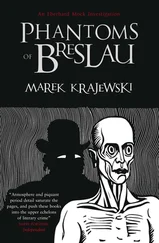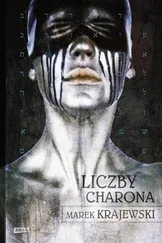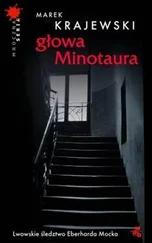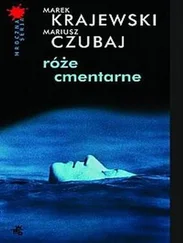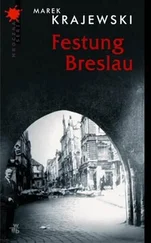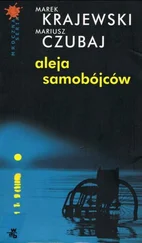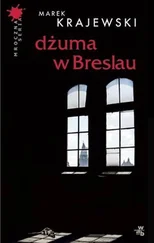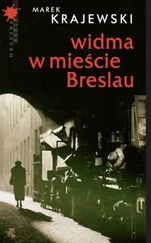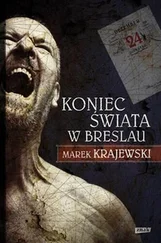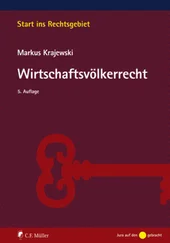Marek Krajewski - Death in Breslau
Здесь есть возможность читать онлайн «Marek Krajewski - Death in Breslau» весь текст электронной книги совершенно бесплатно (целиком полную версию без сокращений). В некоторых случаях можно слушать аудио, скачать через торрент в формате fb2 и присутствует краткое содержание. Жанр: Полицейский детектив, на английском языке. Описание произведения, (предисловие) а так же отзывы посетителей доступны на портале библиотеки ЛибКат.
- Название:Death in Breslau
- Автор:
- Жанр:
- Год:неизвестен
- ISBN:нет данных
- Рейтинг книги:3 / 5. Голосов: 1
-
Избранное:Добавить в избранное
- Отзывы:
-
Ваша оценка:
- 60
- 1
- 2
- 3
- 4
- 5
Death in Breslau: краткое содержание, описание и аннотация
Предлагаем к чтению аннотацию, описание, краткое содержание или предисловие (зависит от того, что написал сам автор книги «Death in Breslau»). Если вы не нашли необходимую информацию о книге — напишите в комментариях, мы постараемся отыскать её.
Death in Breslau — читать онлайн бесплатно полную книгу (весь текст) целиком
Ниже представлен текст книги, разбитый по страницам. Система сохранения места последней прочитанной страницы, позволяет с удобством читать онлайн бесплатно книгу «Death in Breslau», без необходимости каждый раз заново искать на чём Вы остановились. Поставьте закладку, и сможете в любой момент перейти на страницу, на которой закончили чтение.
Интервал:
Закладка:
Mock choked on his coffee, black drops sprayed his pale suit. Anwaldt gave a start and experienced the action of that hormone which, in human beings, is responsible for making bodily hair stand on end. Both then smoked in silence. Observing the impression he had made on his listeners, Hartner could scarcely contain himself for joy, which contrasted rather strangely with the gloomy history of the Yesidis and Crusaders. Mock broke the silence:
“I’m lost for words to thank you, sir, for such an insightful, expert appraisal. My assistant and myself, we are deeply moved, bearing in mind that this whole story throws new light on our puzzle. Will you allow me, sir, to ask you a few questions? This will inevitably mean betraying a few secrets concerning the investigation, which you will be so kind as to keep to yourself.”
“Naturally. I’m listening.”
“From your expert report, one could conclude that Marietta von der Malten’s murder was revenge taken after centuries. The bloody writing in the saloon carriage, taken from a work unknown to anyone and generally considered to be lost, testifies to this. My first question is: could Professor Andreae who is, after all, well acquainted with Eastern writings and languages, for some reason be unable to decipher the quotation? Because if you exclude that, it will be clear that he deliberately misled us.”
“My dear sir, Andreae did not understand the writing. It’s obvious. This scholar is, above all, a specialist in Turkish studies and, as far as I know, knows no Eastern language apart from Turkish, Arabic, Hebrew, Syrian and Coptic. Whereas Ibn Sahim’s chronicle is written in Persian. The Yesidis spoke Persian; today they use Kurdish. Try giving an expert — however excellent — in the Hebrew language a text in Yiddish but written in the Hebraic alphabet, and I assure you that without knowing Yiddish, he’ll be helpless. Andreae knew Arabic writing because, until recently, Turkish texts used to be written only in Arabic. But he does not know Persian, I know that perfectly well because I used to be one of his students. So, he saw a text written in the Arabic alphabet, which he knows, but he hardly understood any of the text. Since he is trying, at any price, to salvage his academic prestige, he concocted a translation from, as it were, ancient Syrian. And he has, by the by, concocted more than once. He once invented some Coptic inscriptions basing his post-doctoral thesis on them …”
“If Maass discovered the chronicle …” — this time it was Anwaldt who spoke — “a fragment of which was found on the wall of the saloon carriage … that means he’s the murderer. Unless someone else, who had dealings with the text before him, slipped it to Maass for some reason. Did anyone before Maass use any of the three manuscripts bound together?”
“I checked most meticulously the reading-room loan register of the last twenty years, and the answer is: no. Since 1913 — because that’s the date the records start — no-one before Maass made use of the manuscripts which are bound together.”
“Dear Herbert,” Mock’s voice resounded, “Maass has a cast-iron alibi. On May 12th, 1933, he gave two lectures in Konigsberg, and this has been confirmed by six of his listeners. On the other hand he does undoubtedly have something to do with the murderers. Why otherwise would he deceive us and translate the text from the carriage quite differently? And apart from that, how did he know that the manuscript could be found here? Maybe he stumbled on the traces of this Persian chronicle when he was researching Marietta’s obituary? But, I should apologize, these questions are for Maass. Sir,” he addressed Hartner again, “is it possible that someone could have read this manuscript without leaving any trace in the records?”
“No librarian will lend out a manuscript without writing it down in the notebook. Besides, only scholars with appropriate references from the university can handle the manuscripts.”
“Unless the librarian colluded with the reader and did not make the rightful entry.”
“Such a collusion, I cannot exclude.”
“Do you employ anyone who has completed their Oriental Studies?”
“Not at the moment. Two years ago, a librarian who was a specialist in Arabic worked for me; he moved to Marburg where he was appointed to a chair at the university.”
“Name?”
“Otto Specht.”
“There’s one question gnawing at me,” Anwaldt said quietly, while putting the name in his notebook. “Why was Marietta von der Malten’s murder so contrived? Is it perhaps because the children of the arch-Yesidi, so to speak, were killed in an equally cruel manner? Is it that the means used in vengeance have to correspond exactly to the crime committed centuries ago? What really happened? What does the chronicler write about it?”
Hartner shuddered with the cold and poured himself another cup of steaming coffee.
“A very good question. Let us give the voice to the Persian chronicle.”
XI
MESOPOTAMIA, DJABAL SINDJAR MOUNTAINS, THREE DAYS ON HORSEBACK WEST OF MOSUL. SECOND SAFAR OF THE SIX HUNDRED FIRST YEAR OF HIDJRA
Here speaks Ibn Sahim, son of Hussain, may Allah have mercy on him. This chapter contains information about the just vengeance taken by Allah’s soldier on the children of the Satanic pir, may his name be cursed for ever and ever …
The evening sun was slipping ever lower across the blue firmament. The outlines of the mountains were becoming sharper and the air clearer. Above the steep crag, the suite of riders moved slowly. At its head rode two leaders: a Crusader and a Turkish warrior. When they had reached the edge of the mountainous ravine beyond which stretched a gentle slope, they brought their horses to a halt and with obvious satisfaction stretched out beneath the stone meanderings of rocks which brought to mind cathedral spires. About forty of the accompanying riders, half of them Christian, half Muslim, did the same. With relief, the Crusader removed his helmet, called a salada , the elongated back end of which had impressed a red, swollen band on his wet neck. Rivulets of sweat escaped from beneath the basinet and ran down the tunic adorned with Maltese crosses. His mount, harnessed in a nose-band of finely wrought work, was breathing freely; white sheets of froth slipped down its sides.
Tiredness did not seem to trouble so much the Turkish knight, who was examining the Crusader’s crossbow with curiosity. He wore, as did his soldiers, a basinet, a helmet bound in a piece of white material, a coat of mail, white trousers reaching just below his knees, and high, black boots. The weapons of the Turk and his men consisted of horn bows and quivers with three-feathered arrows, and Arabian swords called saif . On top of that, the leader wielded an iron pick-axe embossed with silver in shapes of Arabic ornaments.
After a moment had passed, the Christian knight stopped wiping away the sweat, the Saracen lost interest in the crossbow. Both attentively observed the valley which stretched beyond the rocky slope. A low yet wide temple stood among green palm trees. Small alcoves had been hewn into its walls where olive lamps burned, blackening all around with smoke. Every now and then, someone approached the fire, passed their right hand over the flame and, with blackened hand, touched their right brow. The horsemen were paying less attention to this strange behaviour; they were more interested in the number of people in the valley. With a great effort and independently of each other, they counted and arrived at a similar result: in the vicinity of the temple and houses adjoined to it, milled around about two hundred people of both sexes and all ages. The men dressed in tight hair shirts and black turbans drew their attention in particular — they were making sure that not a single oil lamp went out. When a lamp began to burn down, they dipped fresh wicks into olive oil and the flame, hissing, fired up again.
Читать дальшеИнтервал:
Закладка:
Похожие книги на «Death in Breslau»
Представляем Вашему вниманию похожие книги на «Death in Breslau» списком для выбора. Мы отобрали схожую по названию и смыслу литературу в надежде предоставить читателям больше вариантов отыскать новые, интересные, ещё непрочитанные произведения.
Обсуждение, отзывы о книге «Death in Breslau» и просто собственные мнения читателей. Оставьте ваши комментарии, напишите, что Вы думаете о произведении, его смысле или главных героях. Укажите что конкретно понравилось, а что нет, и почему Вы так считаете.

